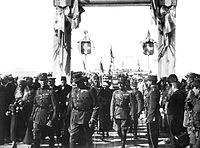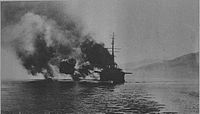User:Sandoria/Sandbox3: Difference between revisions
No edit summary |
No edit summary |
||
| Line 1: | Line 1: | ||
{{Infobox military conflict | {{Infobox military conflict | ||
| conflict = | | conflict = November Events | ||
| width = | | width = | ||
| partof = | | partof = | ||
| image = | | image = Cour martiale à Athènes, jugement du prince André de Grèce.jpg | ||
| image_size = | | image_size = | ||
| alt = | | alt = | ||
| caption = | | caption = Council of military coup commanders after taking over Ocerto | ||
| date = | | date = 7 November 1925 | ||
| place = [[Paretia]] | | place = [[Paretia]] | ||
| coordinates = <!--Use the {{coord}} template --> | | coordinates = <!--Use the {{coord}} template --> | ||
| Line 58: | Line 58: | ||
| campaignbox = | | campaignbox = | ||
}} | }} | ||
The '''Eventos de Novembro''' ("November Events"), or the '''1925 Paretian coup''', was a political dispute that culminated in the takeover of Paretia by the [[New Nation of Paretia Party]] and [[Carlos Palmeira]]. It lasted from August to November 1925. It saw the conflict between liberal supporters of [[Xulio Sousa]], the elected Premier of Paretia in the 1925 election, and the functionalist supporters of Palmeira, supported by Queen [[Roberta II]]. The coup was lead by the monarchy, pro-functionalist military, and Gaullican forces. Gaullican troops would occupy parts of Paretia and shut down ports to help facitate the coup. | |||
==Events== | |||
===Election=== | |||
{{multiple image | |||
|align=left | |||
|image1=Ελευθέριος Βενιζέλος (cropped).jpg | |||
|width1= 154 | |||
|caption1= [[Xulio Sousa]], leader of the [[Democratic Party of Paretia]] | |||
|alt1= = | |||
|width2= 170 | |||
|caption2= [[Carlos Palmeira]], leader of the [[New Nation of Paretia Party]] | |||
|image2=Ioannis Metaxas 1937 (cropped) 2.jpg | |||
|alt2== | |||
}} By 1925 the Paretian atmosphere was already in turmoil, like Etruria, Paretia was indecisive over aligning with Gaullica and the [[Entente]], or Estmere and their allies, as global tensions began to rise. By the 1925 election many voters either sided with the liberal big-tent [[Democratic Party of Paretia]] and their alliance, or the [[New Nation of Paretia Party]], and allies. | |||
The [[1925 Paretian election]] saw the victory of Sousa and the PDP-led alliance by a slim margin against the PNNP. The PDP would also allied with [[Paretian Section of the Workers' International]] in forming a government. Carlos Palmeira objected to the results and called upon the people the protest the election. Queen [[Roberta II]], a devout functionalist and leader in the PNNP, also refused to appoint Sousa officially as Premier. | |||
===Conflict=== | |||
[[File:153 6 acclamation de la foule à Salonique de Venizelos.jpg|230px|thumb|left|Pro-Sousa protesters in Precea in September 1925]] In August 1925 protests would erupt in many cities, with lots of them initially being pro-functionalist, with counterprotests being mostly pro-Sousa in support of the new government. Roberta II would eventually appoint Sousa due to threats by the PDP-run Senate to strip her of powers. The government would attempt to reform the military to rid of functionalist support and would attempt to ban functionalist paramilitaries, this however was not seen through. | |||
Street brawls became much more violent, they already had been on the rise in the previous months, but the violence reached a tipping point during August to November 1925. Paramilitaries such as the Army of the New Nation would be used to fight protesters in support of Sousa, and the fairly pro-functionalist police and military stood back during these attacks. Many civilians would be hurt in these protests, as they included physical violence, firebombings, and other attacks. | |||
The protests would continue into September and October as Palmeira continued to fan the flames against Sousa. Roberta II and pro-functionalist military leaders met to plan to take over the government, and would secretly plan to work with functionalist Gaullican forces. | |||
===Coup=== | |||
[[File:Greek occupation troops landing on Smyrna.jpg|200px|thumb|right|Functionalist troops in Precea]] | |||
[[File:162 9 le Mirabeau bombarde Ahènes.jpg|200px|thumb|left|Gaullican ship ''Yvettine'' fires on Paretian loyalist ships]] | |||
===Aftermath=== | |||
[[File:GaullicanParetiacoup.jpg|250px|thumb|right|Gaullican troops with Tosuton children after the coup]] | |||
Revision as of 04:07, 17 July 2023
| November Events | |||||||
|---|---|---|---|---|---|---|---|
 Council of military coup commanders after taking over Ocerto | |||||||
| |||||||
| Belligerents | |||||||
Support: |
Support: | ||||||
| Commanders and leaders | |||||||
|
Xulio Sousa Otávio Henriques |
Carlos Palmeira Roberta II | ||||||
The Eventos de Novembro ("November Events"), or the 1925 Paretian coup, was a political dispute that culminated in the takeover of Paretia by the New Nation of Paretia Party and Carlos Palmeira. It lasted from August to November 1925. It saw the conflict between liberal supporters of Xulio Sousa, the elected Premier of Paretia in the 1925 election, and the functionalist supporters of Palmeira, supported by Queen Roberta II. The coup was lead by the monarchy, pro-functionalist military, and Gaullican forces. Gaullican troops would occupy parts of Paretia and shut down ports to help facitate the coup.
Events
Election
By 1925 the Paretian atmosphere was already in turmoil, like Etruria, Paretia was indecisive over aligning with Gaullica and the Entente, or Estmere and their allies, as global tensions began to rise. By the 1925 election many voters either sided with the liberal big-tent Democratic Party of Paretia and their alliance, or the New Nation of Paretia Party, and allies.
The 1925 Paretian election saw the victory of Sousa and the PDP-led alliance by a slim margin against the PNNP. The PDP would also allied with Paretian Section of the Workers' International in forming a government. Carlos Palmeira objected to the results and called upon the people the protest the election. Queen Roberta II, a devout functionalist and leader in the PNNP, also refused to appoint Sousa officially as Premier.
Conflict
In August 1925 protests would erupt in many cities, with lots of them initially being pro-functionalist, with counterprotests being mostly pro-Sousa in support of the new government. Roberta II would eventually appoint Sousa due to threats by the PDP-run Senate to strip her of powers. The government would attempt to reform the military to rid of functionalist support and would attempt to ban functionalist paramilitaries, this however was not seen through.
Street brawls became much more violent, they already had been on the rise in the previous months, but the violence reached a tipping point during August to November 1925. Paramilitaries such as the Army of the New Nation would be used to fight protesters in support of Sousa, and the fairly pro-functionalist police and military stood back during these attacks. Many civilians would be hurt in these protests, as they included physical violence, firebombings, and other attacks.
The protests would continue into September and October as Palmeira continued to fan the flames against Sousa. Roberta II and pro-functionalist military leaders met to plan to take over the government, and would secretly plan to work with functionalist Gaullican forces.





